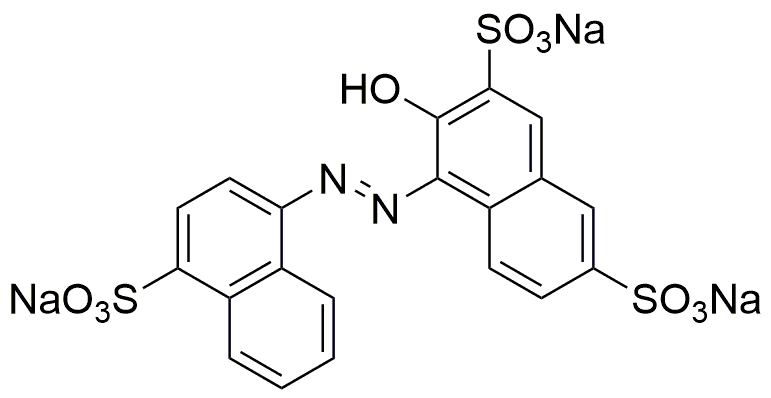Acid red 27 is widely utilized in research focused on:
- Dyeing and Textile Industry: This compound is primarily used as a dye in textiles, providing vibrant red colors to fabrics. Its excellent lightfastness makes it suitable for products that require durability.
- Food Industry: It serves as a food coloring agent, enhancing the visual appeal of various food products. Its safety and regulatory approval make it a popular choice for manufacturers.
- Biological Research: Acid red 27 is employed in staining techniques for microscopy, helping researchers visualize cellular structures and processes effectively.
- Cosmetics: The compound is used in cosmetic formulations for coloring purposes, ensuring that products meet aesthetic standards while remaining safe for skin application.
- Environmental Monitoring: It is utilized in analytical chemistry for detecting and quantifying pollutants in water samples, aiding in environmental protection efforts.
General Information
Properties
Safety and Regulations
Applications
Acid red 27 is widely utilized in research focused on:
- Dyeing and Textile Industry: This compound is primarily used as a dye in textiles, providing vibrant red colors to fabrics. Its excellent lightfastness makes it suitable for products that require durability.
- Food Industry: It serves as a food coloring agent, enhancing the visual appeal of various food products. Its safety and regulatory approval make it a popular choice for manufacturers.
- Biological Research: Acid red 27 is employed in staining techniques for microscopy, helping researchers visualize cellular structures and processes effectively.
- Cosmetics: The compound is used in cosmetic formulations for coloring purposes, ensuring that products meet aesthetic standards while remaining safe for skin application.
- Environmental Monitoring: It is utilized in analytical chemistry for detecting and quantifying pollutants in water samples, aiding in environmental protection efforts.
Documents
Safety Data Sheets (SDS)
The SDS provides comprehensive safety information on handling, storage, and disposal of the product.
Product Specification (PS)
The PS provides a comprehensive breakdown of the product’s properties, including chemical composition, physical state, purity, and storage requirements. It also details acceptable quality ranges and the product's intended applications.
Certificates of Analysis (COA)
Search for Certificates of Analysis (COA) by entering the products Lot Number. Lot and Batch Numbers can be found on a product’s label following the words ‘Lot’ or ‘Batch’.
*Catalog Number
*Lot Number
Certificates Of Origin (COO)
This COO confirms the country where the product was manufactured, and also details the materials and components used in it and whether it is derived from natural, synthetic, or other specific sources. This certificate may be required for customs, trade, and regulatory compliance.
*Catalog Number
*Lot Number
Safety Data Sheets (SDS)
The SDS provides comprehensive safety information on handling, storage, and disposal of the product.
DownloadProduct Specification (PS)
The PS provides a comprehensive breakdown of the product’s properties, including chemical composition, physical state, purity, and storage requirements. It also details acceptable quality ranges and the product's intended applications.
DownloadCertificates of Analysis (COA)
Search for Certificates of Analysis (COA) by entering the products Lot Number. Lot and Batch Numbers can be found on a product’s label following the words ‘Lot’ or ‘Batch’.
*Catalog Number
*Lot Number
Certificates Of Origin (COO)
This COO confirms the country where the product was manufactured, and also details the materials and components used in it and whether it is derived from natural, synthetic, or other specific sources. This certificate may be required for customs, trade, and regulatory compliance.


